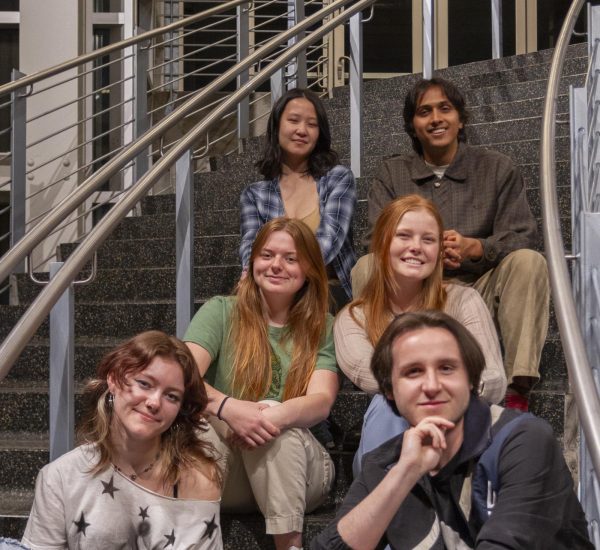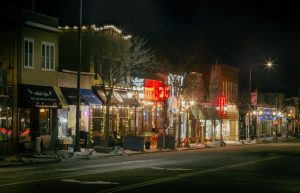Dear first-year: I would like to tell you about something you’ve missed by sheer days. Dear you, those who have traversed this campus back and forth countless times. Think about Dupre hall. Imagine it in all its architectural monotony of narrow windows and lackluster walls. No, don’t imagine it going up in flames (though I understand your reasoning). How could the all-familiar dorm be made more fitting for your colorful lives, your countless procrastinations,… ahem, aspirations? Wouldn’t it be nice if, instead of an off-white wall around the corner, you were greeted by an image of a funky, cartoonish, offbeat giraffe?
It has been done before. I will bring a single individual as an example, though my intention is to advocate for every artist engaged in public art on this campus.
As a first-year, Sherry (Muyuan) He populated Dupre and Doty with characters much like the giraffe I’ve mentioned—cats hanging by the tail from weird corners of the stairs, rainbow butterflies, whales exhaling large puffs of clouds. While they were made of cheap (or not-so) cardboard bought with Sherry’s own means, those installations were worth a smile after a long school day, or a pause in the hustle of workdays. A transparent painting of blooming rosy sakuras decorated the spacious glass window on the first floor. Sherry also made a ‘portrait’ of the dorm from the perspective of that familiar lamppost just outside the entrance. Can you see it exuding thick acrylic brush strokes of color instead of the plain white light? She saw it as that—the gray Dupre reflecting a rich spectrum of color.
At the end of the year, Sherry was asked to take the paper installations down; the blooming sakuras, by a stroke of fate, were removed together with the glass as the window was replaced.
Sherry is a senior now. Her passion for creating public art by (literally) all means available, has turned into a lifestyle. This summer, Sherry, along with Samantha Leopold-Sullivan, Jon Straker and Jamie Morrow, was part of the student team that cooperated with Karen Gubitz of the national basketry organization to create complex basket-woven installations, coiling up the birches by our Campus Center. Check it out—the National Basketry Organization posted a photo of the artwork by the CC, stating that it “will greet Macalester’s students when they return in the fall and remain in place into the winter” (http://nationalbasketry.org/ over-under-e-news-august-2015-issue/).
I am now aware that we were greeted by bare trees. The college security sent an email to the art department coordinator, stating that the sculpture would be taken down. To save the sculpture from non-professional handling, representatives from the art department removed the baskets before the first-year class set foot on campus, as requested. Presumably, the weavings posed a hazard, and were potentially disruptive of the natural growth course of birch trees. However, Karen Gubitz, an experienced weaver, has done such artwork before, and ensured that the materials wouldn’t hurt the plant. In fact, the baskets are made to expand slightly as the bark grows.
While I respect the college’s concern for the hazardous aspects of public art, I would like to voice a suspicion that there is more at stake here. The public architectural image of Macalester echoes the collegiate-gothic red-brick monotony of the upper echelons of American higher education. This image is heavy with obsolete conjurings of a ‘type’ of a student to match the symbols of power embedded in these walls. Of course, the image Macalester wishes to project to prospective students and the public must be in sync with the ‘proper,’ clean spaces structured via the fundraised millions. Dupre’s paper giraffe can’t do as a representation of Macalester’s rigor. Where does it belong, then, the scandalous giraffe, and its kin? Gallery spaces, meant for intentional explosions of creativity, are likewise restrictive. They don’t spill, don’t disrupt, don’t call for action even if they seem to proclaim they do. People enter those spaces for authorized moments of passive interaction with orderly chaotic pieces located in the gaps between clean, white, four walls (occasional architectural flimsies aside).
Systematic structuring of artwork visibility carries on in the spaces beyond Macalester, so it would be unfair to single out college policies in this regard. Yet we as Mac students are encouraged to use at least our four years here to transgress the boundaries of ‘ordinary,’ and reach out into uncomfortable spaces; and so, to celebrate the ‘multi-’ component of multiculturalism. One way to remind ourselves that this is, in fact, what we might be doing with our time here is to pay attention to beacons, to points where questions reach out to us themselves. Think about last year’s collaborative installation art piece, the Mock Border Wall. The piece had been removed to a place of lesser visibility, so that it would not offer a question that the administration did not want to be asked. Questions are moved, out of sight, out of mind.
It seems that Macalester celebrates ‘public’ art only when it is either confined to a gallery space (not entirely public or open by default), or when it is transient enough to leave the historically constructed spaces as they are. Public art is ‘good’, as long as it can be erased, taken down on time, so long as chalked words and images on the pavement can be washed off with rain. I realize that in many cases Sherry’s artwork, and its like, does create fire hazards and disruptions—yet I would appreciate a clearer policy on what constitutes a hazard, and where precisely. Thus far, permissions to complete public art have been arbitrary, and subject to situational change. The absence of clear rules allows for censoring, and monitoring, of public spaces. So I can’t help but wonder how long it takes till the next public theater, poetry, sculpture or other artwork on campus is taken down shortly after its emergence. Vague safety rules for the artistic use of public spaces, as well as the politics of space and its ownership, leave artists frustrated, obliged to tear apart their work, ‘or else.’
Last year, Sherry placed a hundred tiny stones on a shelf within one of the arts building staircases. Rocks don’t burn. It was an ingenuous way to bypass the fire hazard risk in that space, yet the piece was ultimately removed by request. Two words were laid out with the stones—‘You rock’. I think the questions Sherry’s art is asking are simple and powerful—have you made anyone smile today? How much of a curious child is in you today? Have you observed the colors with which your world vibrates? Do you want to keep walking in straight lines, seeing in straight lines, thinking in straight, off-white, lines? Do you?











Jonathan Morgan • Sep 11, 2019 at 3:45 pm
Hi there! This post could not be written any better! Reading this post reminds me of my previous room mate! He always kept talking about this. I will forward this page to him. Fairly certain he will have a good read. Thank you for sharing!
Lillian Lee • Sep 10, 2019 at 10:00 am
I will immediately seize your rss feed as I can’t to find your email subscription link or newsletter service. Do you’ve any? Kindly allow me recognize in order that I could subscribe. Thanks.
Nicholas Marshall • Sep 5, 2019 at 2:43 pm
Wow, this paragraph is fastidious, my sister is analyzing these things, therefore I am going to tell her.